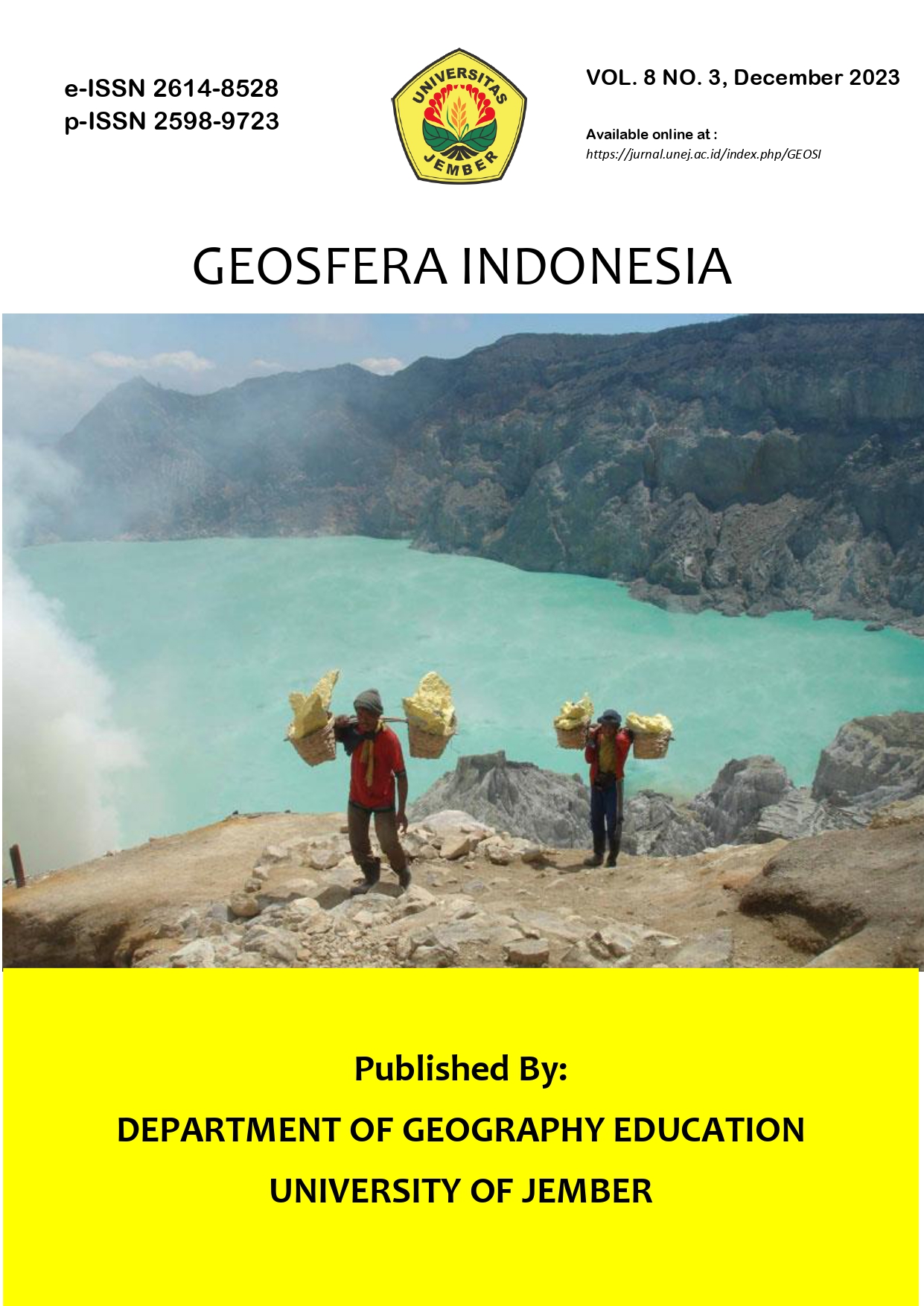Are Community Preparing for Coastal Hazards? A Case Study on a Small Island in Aceh, Indonesia
DOI:
https://doi.org/10.19184/geosi.v8i3.31191Keywords:
Coastal Hazards, Tidal Flood, PreparednessAbstract
Coastal areas are experiencing a high population density that is increasing the vulnerability of community to coastal hazards. Therefore, this study aimed to comprehensively evaluate the preparation level of community to confront coastal hazards. Disaster preparedness was recognized to play an essential role in reducing potential losses caused by flood. However, limited studies assessed community preparedness on small islands using face-to-face interviews with community. A household survey was also conducted on community living on Pusong Island. The results showed that community preparedness was still low (38.34% of 100). Even though tidal flood events were experienced, community were not forced to take preparedness actions and move from Pusong Island. The low level was due to socialization activities and community capacity building related to coastal hazards rarely performed by the government. This study also suggested the importance of increasing the preparedness on remote islands through integrated coastal area management.
Downloads
References
Aksa, F.I. (2021). Wisdom of indigenous and tacit knowledge for disaster risk reduction. Indonesian Journal of Geography, 52(3). https://doi.org/10.22146/IJG.47321.
Aksa, F. I., & Afrian, R. (2022). Community adaptation strategies toward tidal flood: A Case study in Langsa, Indonesia. Jamba: Journal of Disaster Risk Studies, 14(1), 1–8. https://doi.org/10.4102/JAMBA.V14I1.1258.
Aksa, F.I., & Sinulingga, E. (2022). Risk Perception and Preparedness in Flash Flood-Affected Communities: Evidence from Bahorok, Indonesia. Geosfera Indonesia, 7(1), 61. https://doi.org/10.19184/geosi.v7i1.28645.
Aksa, F. I., Utaya, S., Bachri, S., & Handoyo, B. (2020). The role of knowledge and fatalism in college students related to the earthquake-risk perception. Jà mbá: Journal of Disaster Risk Studies, 12(1), 1-6.
Arif, D., Mardiatna, D., & Giyarsih, S. R. (2017). Kerentanan Masyarakat Perkotaan terhadap Bahaya Banjir. Majalah Geografi Indonesia, 3 (2)(September), 79–87.
Bosschaart, A., Kuiper, W., Van der Schee, J., & Schoonenboom, J. (2013). The role of knowledge in students’ flood-risk perception. Natural Hazards, 69(3), 1661–1680. https://doi.org/10.1007/s11069-013-0774-z.
By, C., Lindell, M. K., & Perry, R. W. (2018). Communicating Environmental Risk in Multiethnic Communities Hazard Awareness as Risk Communication. Sage publications.
Cope, M. R., Lee, M. R., Slack, T., Blanchard, T. C., Carney, J., Lipschitz, F., & Gikas, L. (2018). Geographically distant social networks elevate perceived preparedness for coastal environmental threats. Population and Environment, 39(3), 277–296. https://doi.org/10.1007/s11111-017-0292-0.
Fox-Rogers, L., Devitt, C., O’Neill, E., Brereton, F., & Clinch, J. P. (2016). Is there really “nothing you can do� Pathways to enhanced flood-risk preparedness. Journal of Hydrology, 543, 330–343. https://doi.org/10.1016/j.jhydrol.2016.10.009.
Gaillard, J. C., Cadag, J. R. D., & Rampengan, M. M. F. (2019). People’s capacities in facing hazards and disasters: an overview. Natural Hazards, 95(3), 863–876. https://doi.org/10.1007/s11069-018-3519-1.
Gaillard, J. C., & Mercer, J. (2013). From knowledge to action: Bridging gaps in disaster risk reduction. Progress in Human Geography, 37(1), 93–114. https://doi.org/10.1177/0309132512446717.
Hanson, S., Nicholls, R., Ranger, N., Hallegatte, S., Corfee-Morlot, J., Herweijer, C., & Chateau, J. (2011). A global ranking of port cities with high exposure to climate extremes. Climatic Change, 104(1), 89–111. https://doi.org/10.1007/s10584-010-9977-4.
Harwitasari, D., & Ast, J. A. Van. (2011). Climate change adaptation in practice : people ’ s responses to tidal Flooding in Semarang , Indonesia. Journal of Flood Risk Management, 4, 216–233. https://doi.org/10.1111/j.1753-318X.2011.01104.x.
Lauer, M. (2012). Oral traditions or situated practices? Understanding how indigenous communities respond to environmental disasters. Human Organization, 71(2), 176–187. https://doi.org/10.17730/humo.71.2.j0w0101277ww6084.
Lindell, M. K., & Perry, R. W. (2012). The Protective Action Decision Model: Theoretical Modifications and Additional Evidence. Risk Analysis, 32(4), 616–632. https://doi.org/10.1111/j.1539-6924.2011.01647.x.
Marfai, M. A., Sekaranom, A. B., & Ward, P. (2015). Community responses and adaptation strategies toward flood hazard in Jakarta, Indonesia. Natural Hazards, 75(2), 1127–1144. https://doi.org/10.1007/s11069-014-1365-3.
Neumann, B., Vafeidis, A. T., Zimmermann, J., & Nicholls, R. J. (2015). Future coastal population growth and exposure to sea-level rise and coastal flooding - A global assessment. PLoS ONE, 10(3). https://doi.org/10.1371/journal.pone.0118571.
Oktari, R. S., & Comfort, L. K. (2019). Measuring coastal cities’ resilience toward coastal hazards: Instrument development and validation. Progress in Disaster Science, 100057. https://doi.org/10.1016/j.pdisas.2019.100057.
Oktari, R. S., Munadi, K., Idroes, R., & Sofyan, H. (2021). Knowledge creation for community resilience (Kccr): A conceptual model. Journal of Disaster Research, 16(7), 1097–1106. https://doi.org/10.20965/jdr.2021.p1097.
Oktari, R. S., Syamsidik, Idroes, R., Sofyan, H., & Munadi, K. (2020). City Resilience towards Coastal Hazards : An Integrated Bottom-Up and Top-Down Assessment. Water, 12, 1–22.
Paton, D. (2003). Disaster preparedness: A social-cognitive perspective. Disaster Prevention and Management: An International Journal, 12(3), 210–216. https://doi.org/10.1108/09653560310480686.
Rampengan, M. M. F., Boedhihartono, A. K., Law, L., Gaillard, J. C., & Sayer, J. (2014). Capacities in Facing Natural Hazards: A Small Island Perspective. International Journal of Disaster Risk Science, 5(4), 247–264. https://doi.org/10.1007/s13753-014-0031-4.
Setten, G., & Lein, H. (2019). “We draw on what we know anywayâ€: The meaning and role of local knowledge in natural hazard management. International Journal of Disaster Risk Reduction, 38. https://doi.org/10.1016/j.ijdrr.2019.101184.
Shultz, J. M., Cohen, M. A., Hermosilla, S., Espinel, Z., & McLean, A. (2016). Disaster risk reduction and sustainable development for small island developing states. Disaster Health, 3(1), 32–44. https://doi.org/10.1080/21665044.2016.1173443.
Syamsidik, R. T. M., Suppasri, A., Fahmi, M., Al’ala, M., Akmal, W., Hafli, T. M., & Fauzia, A. (2020). Challenges in increasing community preparedness against tsunami hazards in tsunami-prone small islands around Sumatra, Indonesia. International Journal of Disaster Risk Reduction, 47, 101572. https://doi.org/10.1016/j.ijdrr.2020.101572.
Tanaka, N., Sasaki, Y., Mowjood, M. I. M., Jinadasa, K. B. S. N., & Homchuen, S. (2007). Coastal vegetation structures and their functions in tsunami protection: Experience of the recent Indian Ocean tsunami. Landscape and Ecological Engineering, 3(1), 33–45. https://doi.org/10.1007/s11355-006-0013-9.
Terry, J. P., & Goff, J. R. (2012). The special vulnerability of Asia-Pacific islands to natural hazards. Geological Society Special Publication, 361(1), 3–5. https://doi.org/10.1144/SP361.2.
UNDP, (2018). United Nations Development Programm. Annual Report 2018. 36. https://www.undp.org/content/undp/en/home/librarypage/corporate/annual-report 2018.html.
Weichselgartner, J., & Pigeon, P. (2015). The Role of Knowledge in Disaster Risk Reduction. International Journal of Disaster Risk Science, 6(2), 107–116. https://doi.org/10.1007/s13753-015-0052-7.




